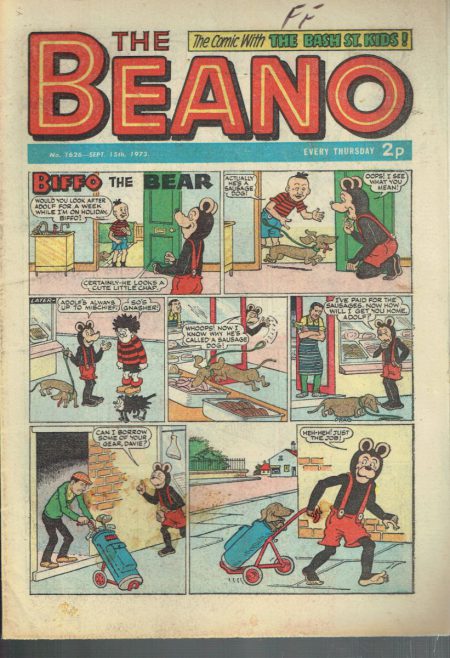
The Beano (formerly The Beano Comic, also known as Beano) is a British anthology comic magazine created by Scottish publishing company DC Thomson. Its first issue was published on 30 July 1938,[1] and it became the world’s longest-running comic issued weekly in 2018, publishing its 4000th issue in August 2019.[2] Popular and well-known comic strips and characters include Dennis the Menace, Minnie the Minx, General Jumbo, The Bash Street Kids, Jack Flash, Ivy the Terrible, Jonah, Lord Snooty and His Pals, and Roger the Dodger.
Intended to be a member for the cancelled “New Big Five”, The Beano was planned as a pioneer of a children’s magazine that only contained comic strips in the style of American newspaper gag-a-days. In the present, its legacy is its misbehaving characters, escapist tales and anarchic humour with an audience of all ages. Starting in the 1940s, Beano became a multimedia franchise with spin-off books and Christmas annuals, websites, theme park rides, games, cartoon adaptations, and a production company.
Throughout the 1920s, DC Thomson dominated the British comics industry. Dubbed “the big five”, the publisher’s most successful comics were Adventure (1921),[3] The Rover and The Wizard (1922),[4][5] The Skipper (1930)[6] and The Hotspur (1933).[7][Note 1] These were weekly issued boys’ magazines for preteen males, containing anthologies by DC Thomson’s creator staff designed in various formats and genres. They became popular throughout the United Kingdom, notably in English industrial cities,[8] helped through the company’s ability to view sales and promotions in the areas much easier than the rival publishers in London.[9] Although many were about “super men” the young readers could idolise,[10] the rest of the stories would be comic strips inspired by the gag-a-day strips in American newspapers full of stylised characters, slapstick and puns.
Overseeing the magazines was the Managing Editor of Children’s Publications, R. D. Low, who first joined the company in 1913. Almost a decade into the big five’s success, the stories shifted to comedic and included more comic strips, which gave Low an idea of creating a new “big five” which focused on the funnies more than drama. The suggestion was approved; editors Bill Blain and (sub-editor) Albert Barnes of The Wizard and The Hotspur, respectively, joined Low’s project.[13] The new team placed a newspaper advertisement into The Daily Telegraph[Note 2] asking for artists and/or comic ideas. With the help of the advertisement responses and employed artists at DC Thomson, The Dandy was published in 1937,[15] the New Big Five’s first member.[13] For The Beano (initially called “The Beano Comic” until issue 412), Low received comic strip suggestions by Reg Carter, an English illustrator in Sussex who had created funnies for several British comics and designed humorous postcards. After an in-person interview, Low and Carter planned the front cover for The Beano‘s first issue, eventually creating the character Big Eggo (originally named Oswald the Ostrich). It would be in colour whilst the inside of the magazine would be black and white,[Note 3] a tactic used for The Dandy‘s first issue (black and white stories inside, colourful Korky the Cat strip on the front). Joining the Big Eggo strip would be many funnies, such as Hugh McNeill’s Ping the Elastic Man, James Jewell’s Wee Peem, Allan Morley‘s Big Fat Joe, Eric Roberts’ Rip Van Wink, Dudley D. Watkins‘ Lord Snooty and His Pals, and Roland Davies‘ Contrary Mary. Despite the aim to make a new comic series full of American-inspired comic strips, The Beano also contained short stories, serial fiction and adventure stories similar to the Big Five’s magazines; Morgyn the Mighty was previously in The Rover.[20] Tin-Can Tommy and Brave Captain Kipper were reprints, co-produced by the Italian art agency Torelli Bros.
Worth 2d with a free prize of a “whoopee mask”, issue 1 of The Beano was released on 26 July 1938 for the 30th,[1] selling roughly 443,000 copies. Like The Dandy, its name is from a Low-led DC Thomson office party called The DB Club (The Dandy Beano Club).[13] DC Thomson had several office party clubs that hosted different types of staff gatherings to choose from (e.g. The Prancers would hike hills), but Low’s DB Club preferred playing golf and dining throughout Dundee. The two magazines also followed the one-word titles of other comics by rival companies, such as Amalgamated Press‘ Crackers,[22] Sparkler,[23] Puck[24] and some books from its Union Jack series (The Marvel, The Magnet and The Gem);[25] and Target Publications’ Chuckler, Rattler and Dazzler.[13] Beano editor-in-chief was George Moonie, former sub-editor of The Wizard, who would be editor until the summer of 1959. He later explained DC Thomson was a competitive company that wanted to make the best children’s literature in the United Kingdom, but there was also competition within itself as Beano offices was determined to beat The Dandy‘s popularity.
World War Two, reaching million sales (1940–1959)
Drastic changes occurred behind the scenes of The Beano during the Second World War: George Moonie and editing partner Ron Fraser left to join the Royal Marines and Air Force, respectively, both not returning until c. 1946. Stuart Gilchrist became sole editor-in-chief after Moonie’s other sub-editor Freddie Simpson became ill and resigned. Contact was also lost with Torelli Bros. so in-house creations of Tin-Can Tommy began from issue 69 by Sam Fair. Paper rationing caused the rest of Low’s New Big Five to be cancelled (it stopped at three published, the third member being The Magic Comic (1939), which ended with 80 issues in 1941), and The Beano to fluctuate its page count instead of its usual 28.[Note 4] Eventually, The Beano became a fortnightly magazine until 23 July 1949.
Comic strips would encourage readers to help their parents and other adults with the war effort, and to be optimistic about the war’s outcome. New comic strips mocked Mussolini[34] and propagandist William Joyce,[35] Lord Snooty and His Pals stories would be about the protagonists outsmarting the Axis leaders,[Note 5] and other stories would be about characters recycling paper. Big Eggo front covers were often about Eggo pranking servicemen during the Blitz, and Pansy Potter received a medal for single-handedly capturing a Nazi U-boat.[38] Issue 192 would debut a 16-part prose story about a boy and his mother being evacuated to the United States and becoming the enemy of a Chicago gangster’s widow.[40]
December 1945 marked a milestone: issue 272 became the first Beano issue to sell over a million copies. The end of the war also ushered in a new era for the comic, debuting superhero Jack Flash[42] and a new generation of trouble-making kids: Dennis the Menace,[43] Minnie the Minx,[44] The Bash Street Kids,[45] and Roger the Dodger.[46] DC Thomson also introduced new comic magazines like The Beezer[47] and The Topper[48] that a few Beano artists also created characters and stories for.
Post-war changes (1960–present)
George Moonie resigned as editor-in-chief in 1959 to develop comics for girls. Sub-editor of The Beezer Harry Cramond succeeded Moonie until retiring in 1984, described as the most influential editor in The Beano‘s history. He oversaw new merchandising, high sales,[Note 6] and the thousandth[54] and two thousandth issues.[55] Behind the scenes of the magazine became humanised throughout the years as DC Thomson’s Beano offices featured on documentary television and Cramond’s successor Euan Kerr guest-starred on television for the magazine’s 50th anniversary.
Magazine revamps also ensued. The Beano began to advertise outside of DC Thomson’s products in 1988 in order to keep both it and The Dandy “pocket money” cheap, beginning with issue 2407.[58] 1975 was the last year to feature an adventure comic as General Jumbo‘s eighth series drew to a close in issue 1734.[59] Issue 2674 was the first issue to feature every page in colour.[60]
From Wikipedia, the free encyclopedia
Supplements / Free Gifts ( when applicable ) are NOT included unless stated
Vintage and Modern Birthday Issues Tilleys Sheffield
CONDITION …. All items listed are used . Items are generally in good condition with
some issues having delivery name to cover,may have little soiling/creasing/browning/
minor tears/spine wear/rusted staples/paper corrosion around staples/thumbing.
|









